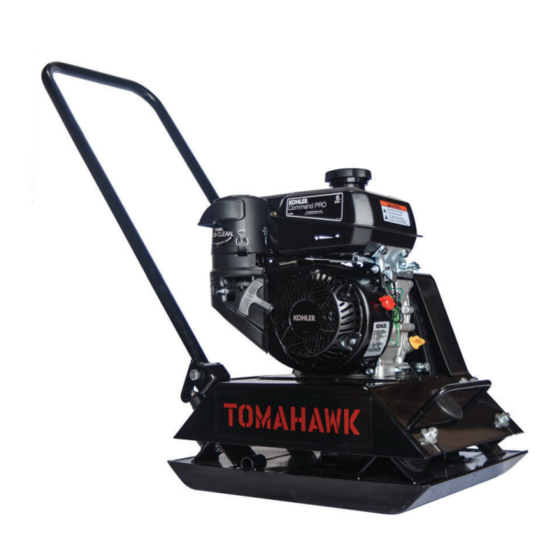Table of Contents
Advertisement
Quick Links
Advertisement
Table of Contents

Subscribe to Our Youtube Channel
Summary of Contents for Tomahawk TPC80
- Page 1 TPC80 Plate Compactor Operation and Instruction Manual...
-
Page 2: Table Of Contents
Table of Contents 1. Safety Information --------------------------------------------------------------------- 1.1 Laws Pertaining to Spark Arresters ---------------------------------------------------------- 1.2 Operating Safety --------------------------------------------------------------------------------- 1.3 Operator Safety while using Gasoline Engines ------------------------------------------ 1.4 Service Safety ------------------------------------------------------------------------------------ 2. Technical Data ----------------------------------------------------------------------------- 2.1 Engine Data --------------------------------------------------------------------------------------- 2.2 Machine Data ------------------------------------------------------------------------------------ 3. -
Page 3: Safety Information
Tomahawk Power. The information contained in this manual is based on machines in production at the time of publication. Tomahawk Power reserves the right to change any portion of this information without notice. -
Page 4: Laws Pertaining To Spark Arresters
1.2.2 NEVER touch the engine or muffler while the engine is on or immediately after it has been turned off. These areas get hot and may cause burns. 1.2.3 NEVER use accessories or attachments that are not recommended by Tomahawk Power. Damage to equipment and injury to the user may result. -
Page 5: Operator Safety While Using Gasoline Engines
1.2.11 ALWAYS store equipment properly when it is not being used. Equipment should be stored in a clean, dry location out of the reach of children. 1.2.12 ALWAYS operate machine with all safety devices and guards in place and in work- ing order. -
Page 6: Technical Data
A hot muffler could ignite them, starting a fire. 1.4.6 ALWAYS replace worn or damaged components with spare parts designed and recommended by Tomahawk Power. 1.4.7 ALWAYS disconnect spark plug on machines equipped with gasoline engines, before servicing, to avoid accidental start-up. -
Page 7: Machine Data
2.2 Machine Data Centrifugal Force 13 Kn Max Exciter Speed 5,800 RPM Compacting Force 3,000 lbs Compaction of Cohesive Soils 22 in Vibration Frequency 100 Hz Vibrations per Minute 6,400 Max Travel Speed ft / min 79 ft / min Plate Depth 21 in Plate Width... -
Page 8: To Start
3.2.2 Check: -Oil level in engine -Fuel level -Condition of air cleaner -Tightness of external fasteners -Condition of fuel lines 3.3 TO Start (Fig.1) 3.3.1 Open fuel valve by moving lever to the right (a1). Note: If engine is cold, move choke lever to close position (b1). If engine is hot, set choke to open position (b2). -
Page 9: To Stop
Plates equipped with water tanks can be used for compacting asphalt. This plate is not recommended for compacting cohesive soils with a heavy clay content. For cohesive soil, use a Tomahawk PMR68. 3.6 Operation (Fig.2) Run engine at full throttle and allow plate to pull itself along at its normal speed. When operating on an incline it may be necessary to assist plate by pushing it forward slightly. -
Page 10: Maintenance
4. Maintenance 4.1 Periodic Maintenance The chart below lists basic engine maintenance. Refer to engine manufacturer's Opera- tion Manual for additional information on engine maintenance. Daily After Every 2 Every Every before first 20 weeks or month or year or starting hours 50 hours... -
Page 11: Drive Belt
4.3 Drive Belt (Fig.3) On new machines or after installing a new belt, check belt tension after first 20 hours of operation. Check and adjust belt every 50 hours thereafter. To change the belt: 4.3.1 Remove the beltguard and remove the four hex nuts (a) holding pulley halves (b) together. -
Page 12: Spark Plug
To change fluid: 4.4.1 Remove beltguard, belt, and hose from water tank. 4.4.2 Remove four screws (b) securing console assembly to baseplate and lift console assembly from baseplate. 4.4.3 Remove end cover (c) from bear- ing exciter assembly. Outer bearing race will remain with cover. -
Page 13: Engine Oil
4.5.1 Remove spark plug and inspect it. 4.5.2 Replace plug if the insulator is cracked or chipped. 4.5.3 Clean spark plug electrodes with a wire brush. 4.5.4 Set the electrode gap (a). 4.5.5 Tighten spark plug securely. CAUTION: A loose spark plug can become very hot and may cause engine damage. -
Page 14: Air Cleaner
4.7 Air Cleaner (Fig. 7) NEVER use gasoline or other types of low flash point solvents for cleaning the air cleaner. A fire or explosion could result. WARNING NEVER run engine without air cleaner: Severe engine damage will occur. CAUTION The engine is equipped with a dual element air clean- er. -
Page 15: Carburetor Adjusment
Fig. 8 4.9 Carburetor Adjustment (Fig. 9) 4.9.1 Start the engine and allow it to warm up to operating temperature. 4.9.2 Set the pilot screw (a) 2 turns out. See Note. 4.9.3 With the engine idling, turn the pilot screw (a) in or out to the setting that produc- es the highest rpm. -
Page 16: Troubleshooting
4.10 Troubleshooting Problem / Symptom Reason / Remedy • Engine throttle control is not completely open. • Throttle control is not adjusted correctly. • Ground is too wet, plate sticking. Allow soil to dry before compacting. -Plate does not develop •... -
Page 17: Lifting Machine
4.12 Lifting Machine See Technical Data for the weight of the machine. To lift machine manually: 4.12.1 Stop the engine. 4.12.2 Obtain help from a partner and plan the lift. 4.12.3 Grasp the machine by its cage and lifting slot. 4.12.4 Lift the machine.








Need help?
Do you have a question about the TPC80 and is the answer not in the manual?
Questions and answers